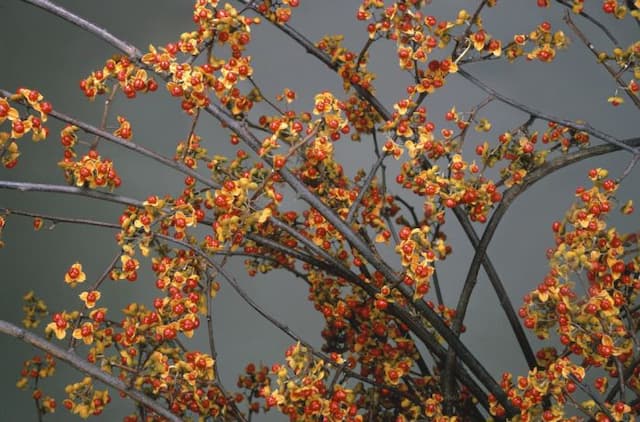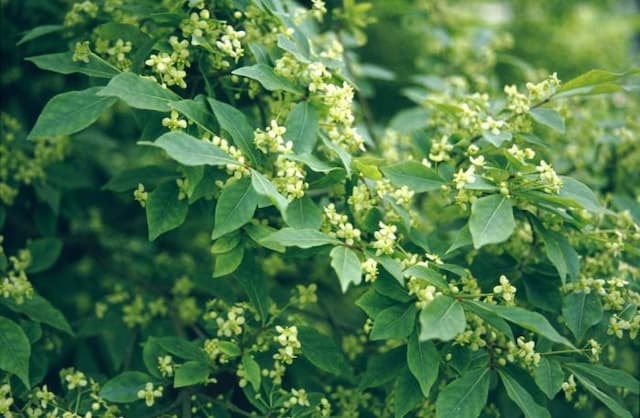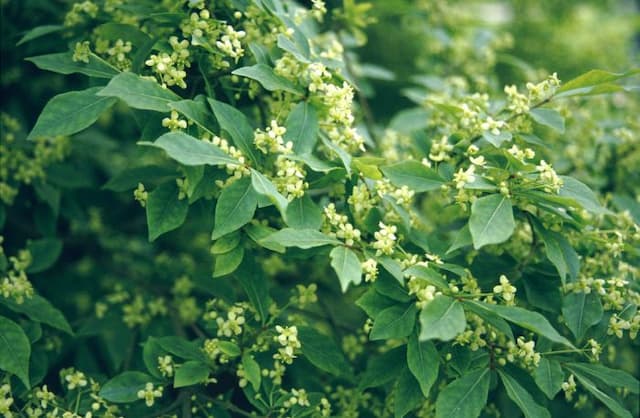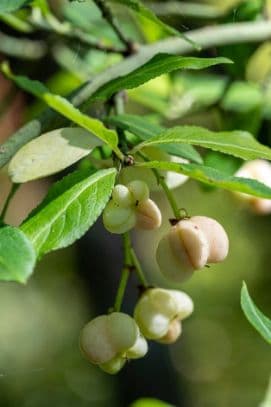Spindle 'Coloratus' Euonymus fortunei 'Coloratus'
ABOUT
A small, bushy evergreen shrub, ideal for ground cover to a height of 60cm, but will climb to 5m if planted against a wall. Leaves are dark green and rounded and turn purple-red in winter; rarely flowers
About this plant
 Names
NamesFamily
Celastraceae.
Synonyms
Wintercreeper, Purple-leaf Wintercreeper, Evergreen Bittersweet, Fortune's Spindle, Wintercreeper Euonymus.
Common names
Euonymus fortunei 'Coloratus'
 Characteristics
CharacteristicsLife cycle
Perennials
Foliage type
Evergreen
Color of leaves
Green
Height
1-2 feet (30-60 cm)
Spread
2-4 feet (60-120 cm)
Plant type
Shrub
Hardiness zones
5
Native area
Asia
Benefits
 General Benefits
General Benefits- Low Maintenance: Requires minimal care once established, making it a convenient choice for gardeners of all levels.
- Drought Tolerant: Can survive with limited water, reducing the need for frequent irrigation.
- Ground Cover: Spreads efficiently to cover ground, preventing weed growth and soil erosion.
- Year-Round Interest: Evergreen leaves provide color and texture in all seasons, with foliage turning purplish-red in fall and winter.
- Versatile: Can be used in various landscape designs, including as a climbing vine, a groundcover, or a container plant.
- Attracts Wildlife: Produces fruits that can attract birds, providing ecological benefits to the garden.
- Hardy: Resists damage from cold and frost, making it suitable for a variety of climates.
- Fast Growing: Establishes quickly, offering rapid coverage and landscape impact.
 Medical Properties
Medical PropertiesThis plant is not used for medical purposes.
 Air-purifying Qualities
Air-purifying QualitiesThis plant is not specifically known for air purifying qualities.
 Other Uses
Other Uses- Wintercreeper can act as a natural bird feeder when its fruit ripens, attracting various bird species to the garden for a food source.
- In outdoor miniature landscapes or fairy gardens, Wintercreeper can be used to create small, hedge-like structures or as a stand-in for large, leafy trees.
- Wintercreeper is used in bonsai cultivation for its small leaves and the ease with which it can be trained and shaped.
- Can be used as a ground cover in large aquariums or terrariums to provide a more natural and textured backdrop.
- As a green roof plant, Wintercreeper can be implemented to provide cover and aesthetic appeal on roof gardens.
- The dense foliage of Wintercreeper can be used in noise reduction gardens to help absorb sound.
- Used in artistic installations and living sculptures, where the vine's clinging nature allows it to shape over various forms.
- Wintercreeper foliage can be harvested and pressed for herbarium collections or botanical art.
- The vine's robustness and ease of propagation make it a good candidate for erosion control on slopes and banks.
- Wintercreeper is sometimes used in classrooms or educational programs to teach plant propagation techniques.
Interesting Facts
 Feng Shui
Feng ShuiThe Wintercreeper is not used in Feng Shui practice.
 Zodiac Sign Compitability
Zodiac Sign CompitabilityThe Wintercreeper is not used in astrology practice.
 Plant Symbolism
Plant Symbolism- Resilience: Euonymus fortunei 'Coloratus', commonly known as Wintercreeper, can thrive in a variety of challenging conditions, symbolizing the ability to endure and adapt.
- Flexibility: Its climbing nature reflects flexibility and the idea of growth in multiple directions, highlighting the importance of versatility in life.
- Fertility: As an evergreen plant, the Wintercreeper symbolizes life and fecundity, often associated with the continuous cycle of growth and renewal.
- Defense: The dense foliage of Wintercreeper can also be seen as a protective barrier, symbolizing safeguarding and shelter.
- Insight: The vibrant color changes in its leaves from green to purple or reddish hues in the fall can represent a deepening of understanding or revelation as one adapts to life's changes.
 Water
WaterThe Wintercreeper needs consistent moisture but does not like to be waterlogged. It should be watered deeply and thoroughly to promote deep root growth, with about 1 gallon per plant every week during its growing season if there is no significant rainfall. In hotter temperatures or during dry spells, increase watering frequency to twice per week. During winter or in cooler temperatures, reduce the amount to a gallon every two weeks. Always check the top inch of the soil; if it feels dry, it's time to water.
 Light
LightWintercreeper thrives in a wide range of light conditions, from full sun to full shade. In full sun, the leaves will often have the best coloration. However, in extremely hot climates, partial shade will prevent scorching of the leaves. A spot that receives morning sunlight with afternoon shade, or dappled sunlight throughout the day, is ideal for this versatile plant.
 Temperature
TemperatureWintercreeper is a hardy plant and can tolerate a range of temperatures but prefers to grow in conditions between 60 and 80 degrees Fahrenheit. This plant can survive minimum temperatures down to about -30 degrees Fahrenheit, although such cold conditions may damage the foliage. Ideal temperature conditions would keep consistently within the preferred range, avoiding the extremes.
 Pruning
PruningPrune the Wintercreeper to maintain its shape and to remove any dead or damaged growth. This can be done at any time, although the best time for major pruning is in the late winter or early spring before new growth begins. Pruning can be done annually, but the plant can also tolerate more frequent trimming if necessary to keep it within bounds or to maintain a particular shape.
 Cleaning
CleaningAs needed
 Soil
SoilWintercreeper thrives best in well-drained soil with a high content of organic matter and a pH range of 6.0 to 7.5. A mixture of loam, sand, and peat moss or compost is ideal.
 Repotting
RepottingWintercreeper does not require frequent repotting and can be repotted every 3 to 4 years or when it is seen to outgrow its current container.
 Humidity & Misting
Humidity & MistingWintercreeper tolerates a wide range of humidity levels, but it performs best in moderate humidity environments without the need for any special humidity adjustments.
 Suitable locations
Suitable locationsIndoor
Plant in well-draining soil, moderate light, don't overwater.
Outdoor
Plant in part shade to full sun, well-draining soil, mulch base.
Hardiness zone
5-9 USDA
 Life cycle
Life cycleThe Wintercreeper (Euonymus fortunei 'Coloratus') starts its life cycle when its seeds germinate in spring, after which young seedlings establish themselves and begin to grow. The juvenile stage of this plant is characterized by rapid growth and the development of its climbing or creeping woody vines that can adhere to surfaces like walls and rocks. As it matures, the Wintercreeper develops dense leafy foliage that is green during the growing season and turns to a purple-red hue in the cold months, offering year-round interest. This evergreen perennial continues to spread and can become ground cover or climb structures over several years through vegetative reproduction via rooting at the nodes. Flowering is typically inconspicuous and occurs in the summer, producing small greenish flowers that give way to pinkish-red fruit capsules containing seeds. The seeds are then dispersed by animals or gravity, and the cycle begins anew, with the plant having a long lifespan if conditions are favorable.
 Propogation
PropogationPropogation time
Late Spring-Early Summer
Propogation: The most popular method of propagating Euonymus fortunei 'Coloratus', also known as Purple Wintercreeper, is through stem cuttings. The best time to take stem cuttings is during the late spring or early summer when the plant's growth is most vigorous. Cut a 4 to 6-inch (10 to 15 cm) piece of stem from a healthy section of the plant, ensuring the cutting has at least two sets of leaves. Remove the leaves from the bottom half of the cutting to expose the nodes, where roots will develop. Dip the cut end into rooting hormone to enhance root production and plant the cutting into a mix of moistened potting soil and perlite, making sure to bury the exposed nodes. Keep the soil consistently moist and place the cutting in a location with bright, indirect light. Roots typically develop within a few weeks, after which the cutting can be transplanted to a larger pot or directly into the garden.





![Spindle [Blondy]](/_next/image?url=https%3A%2F%2Fplants-admin.emdemapps.com%2Fimages%2Fplants%2F%2Fimages%2F604b642f54add.png&w=640&q=75)


